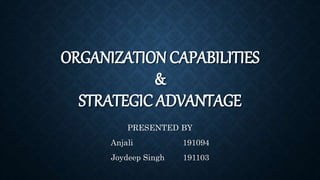
Organization capabilities and strategic advantages
- 1. ORGANIZATION CAPABILITIES & STRATEGIC ADVANTAGE PRESENTED BY Anjali 191094 Joydeep Singh 191103
- 2. INTRODUCTION ORGANIZATION CAPABILITIES ARE THE COLLECTIVE SKILLS, EXPERTISE, AND ALIGNMENT OF THE PEOPLE IN YOUR COMPANY. COMPETENCIES TEND TO BE AT AN INDIVIDUAL LEVEL WHILE CAPABILITIES SPAN ACROSS AN ORGANIZATION.
- 4. STARBUCKS
- 5. • BRANDEQUITY • GLOBAL PRESENCE • PRODUCT QUALITY • SUPPLY CHAIN • CUSTOMER LOYALTY
- 7. •OPERATIONAL CAPABILITY •CUSTOMER SERVICE CAPABILITY •PRODCUT DEVELOPMENTCAPABILITY •DYNAMIC CAPABILITY
- 9. •UNIQUE DSEIGN CAPABILITY •INNOVATION CAPABILITY •POWERFUL BRAND IMAGE •DIFFERENTIATION
- 10. STRATEGIC ADVANTAGE Strategic advantage is “When a company or country has a particular characteristic or way of doing things that makes it more successful than others.” CAMBRIDGE ENGLISH DICTIONARY
- 11. STORY TIME • Kasparov vs Kramnik • Joel Lautier as advisor to Kramnik • Lautier’s job – to find best opening with black pieces • Kramnik Plays – berlin defence Source- http://www.barnetttalks.com/2019/11/strategic-advantage.html
- 12. ANALOGY • VISION Not losing game • MISSION Avoid mid-game complication • ALTERNATE STRATEGIES No. of possible opening and moves • STRATEGIC ADVANTAGE Berlin defense or trading queens • STRENGTH defensive play
- 13. RESOURCE BASED THEORY OF STRATEGY Given by Jay Barney (1991), suggested that firm’s resources should have 4 characteristics to gain sustained competitive advantage. • Valuable • Rare • Costly to imitate • Non-substitutable Jay B. Barney (1991), Firm resources and sustained competitive advantage, Journal of Management.
- 14. STRATEGIC ADVANTAGE DEVELOPMENT FRAMEWORK Azhar Kazmi, Adela Kazmi (2015), Strategic Management, McGraw Hill.
- 15. STRATEGIC ADVANTAGE PROFILE (SAP) • Proposed by Glueck in • PURPOSE – To look for Strategic Alternatives and help in strategic decision- making process
- 16. EVIDENCES AND INSIGHTS FOR GAINING STRATEGIC ADVANTAGES
- 17. STRATEGIC ADVANTAGES FROM ORGANISATIONAL ENVIRONMENT • Roxanne Helm Stevens and Emmanuel Ogunji, in their paper argue that effective management of diversity in organizational environments can used by companies for achieving competitive advantage and gaining strategic advantage. Further they propose that diversity curricula be taught in graduate business school programs to leverage diversity capital and the resulting cultural dexterity for strategic advantage. • Wolfgang C. Amann and Shiv K. Tripathi, in their paper through case studies verifies that innovative, inclusive business interventions have, by solving development problems, helped companies successfully develop a strategic advantage.
- 18. STRATEGIC ADVANTAGES FROM TECHNOLOGY • Technology and Strategic advantage, Robert M. Price describe Superior utilization of technology as the most important ingredient of economic success. In the article he says that technology should be part of strategy and how the companies should leverage its technological resources to have competitive edge in the market. • Jon W. Beard and Mary Sumner, in their paper explored the ERP systems for strategic advantage. They used VRIO framework for strategic analysis and concluded that ERP systems may not provide strategic advantage but the planning, proper management and post-implementation strategic alignment of ERP system can provide competitive advantage.
- 19. EVIDENCE OF STRATEGIC ADVANTAGE FOR SMES • Fabian Gargam in his paper, shows that weakness and vulnerability not always lead to dead end and propose that idiosyncrasies and unique resources can unexpectedly develop of singular way to create strategic advantages. • Dr. Dan H. Kipley, Dr. Alfred O. Lewis, Roxanne Helm, in their paper proposes Small and Medium Sized Not-for-Profits can adapt and successfully implement a Knowledge Management system to competitive advantage even with challenges like limited financial and functional capabilities.
- 20. STRATEGIC ADVANTAGE THROUGH MARKETING • Lance A. Bettencourt, Robert F. Lusch, Stephen L. Vargo, their paper discusses the role of marketing in achieving strategic advantage through services point of view. • Also, they argue that strategic advantage comes less by predicting what will happen in existing markets and more from envisioning service to help customers get jobs done and then preparing to continually learn and re-shape value propositions over time.
- 21. REFERENCES • Jay B. Barney (1991), Firm resources and sustained competitive advantage, Journal of Management. • Price, R. M. (1996). Executive Forum: Technology and Strategic Advantage. California Management Review, 38(3), 38–56. • Beard, J. W., & Sumner, M. (2004). Seeking strategic advantage in the post-net era: viewing ERP systems from the resource-based perspective. The Journal of Strategic Information Systems, 13(2), 129-150. • Helm Stevens, R., & Ogunji, E. (2010). Managing diverse organizational environments for strategic advantage: Exploring the value of developing business diversity curriculum in higher education. Journal of Management Policy and Practice, 11(4), 72-85.
- 22. REFERENCES • Wolfgang C. Amann, Shiv K. Tripathi, (2018). Achieving Sustainable Strategic Advantage through Inclusive Business: Reflections from Selected Cases. Optimization: Journal of Research in Management. • Bettencourt, L. A., Lusch, R. F., & Vargo, S. L. (2014). A Service Lens on Value Creation: Marketing’s Role in Achieving Strategic Advantage. California Management Review, 57(1) • Kipley, D., Lewis, A., & Helm, R. (2008). Achieving Strategic Advantage and Organizational Legitimacy for Small and Medium Sized NFPs through the Implementation of Knowledge Management. The Business Renaissance Quarterly, 3, 21. • Gargam, F. (2020). Unlikely champions: how underdogs create strategic advantages. Journal of Small Business & Entrepreneurship, 1-29.
